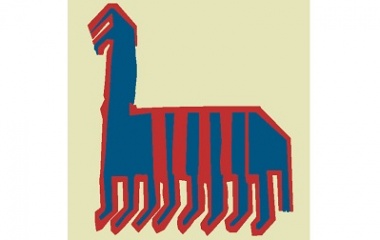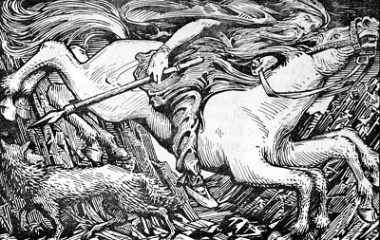Who is Sleipnir?
Sleipnir is Odin’s valiant steed, “the best among horses.” He carries the leader of the Norse gods on many quests, and he never fails to leave common men awestruck by his strength and speed.
Characteristics
Physical Description
Sleipnir is a large, muscular horse with eight legs instead of four. His extra legs are coupled with his regular legs, growing from his shoulders and his haunches. In some depictions of Odin riding Sleipnir, the mighty horse’s extra legs are shackled to his regular legs at the knee. Other works of art show him using all his legs independently.
Sleipnir’s coat is as gray as a thundercloud, and his mane and tail are streams of darker grey. In one story, a Valkyrie mandates that Norse runes should be carved into Sleipnir’s teeth.
Special Abilities
Sleipnir is “the best among horses.” He can gallop faster, jump higher, kick harder, and whinny louder than any other horse, whether it is found grazing on the grass of Midgard or feasting in the rich stables of Asgard. His strength knows no equal, and his heart knows no fear.
In addition to racing over the ground, Odin’s mighty steed can also fly through the air and swim through water. None of the elements slow him down. Famously, he is even able to ferry Odin safely in and out of Hel, the realm of the dead.
Related Creatures
Sleipnir’s lineage explains his freakish form and incredible power. He is the child of Loki and Svaoilfari, a giant stallion who was employed in building a fortification for the gods. Loki, in the shape of a mare, was impregnated by Svaoilfair and later gave birth to Sleipnir. Despite being the product of the devious god Loki and a stallion belonging to the banished race of giants, Sleipnir was accepted by the Norse goods and proved to be a noble-hearted ally.
Sleipnir later has a child of his own, an exceptional young stallion named Grani. Grani takes after his father in size, coloration, and strength, but he doesn’t have eight legs.
Some scholars speculate that Sleipnir is one of Odin’s fylgur. He is a spirit animal who manifests Odin’s true character to other people and who appears to the god himself as an omen before a fated event. As a fylgja, Sleipnir might represent Odin’s power and nobility. He also has an important role to play whenever Odin must confront death, as he does on his trip to Hel and during the battle of Ragnarok.
Cultural Representation
Archaeological Record
Eight-legged horses appear in several of the “picture stones” that have been recovered from ancient Norse Settlements. The Tjangvide Stone (dated back to the eighth century) shows a rider and an eight-legged horse, whose hooves are nested in Norse runes, while the Ardre VIII Stone (also dated to the eighth or ninth century) shows a similar horse and rider tramping through a majestic hall.
Literature
Sleipnir is discussed in both the Poetic Edda and the Prose Edda, which together form the largest volume of our knowledge about early Norse culture. He also rears his head in a number of smaller sagas, including the Volsunga Saga, the Gesta Danorum, and the Hervarar saga ok Heiðreks.
Famous Myths
The extraordinary circumstances that surround the birth of Sleipnir make up a very famous Norse legend. During the early days of Midgard, the gods were approached by a builder who offered to build a fortification for them to keep out invaders. The builder claimed that he could complete this fortress in three seasons, but in exchange, he wanted the goddess Freyja and the sun and the moon as payment. After a heated debate, the gods agreed to the deal, but they stipulated that no man could help the builder, and if the fortress was not complete in three seasons, he would receive no payment.
When he heard the gods’ conditions, the builder begged to be allowed the help of his stallion, Svaoilfair. Loki convinced the other gods to allow this, and the builder began work. Much to the amazement and chagrin of the gods, they soon found that the builder and his stallion were equal to their task. The stallion hauled enormous rocks to the building site day in and day out, and by the time the project’s deadline approached, it was clear the builder would finish his work.
The gods were enraged. They had never intended to pay the builder and had depended on him failing to meet the project’s deadline. They took their wrath out on Loki, as it was obvious that the builder couldn’t have completed his task without the help of his stallion. If Loki didn’t find a way to interrupt the builder’s progress, the gods swore they would sentence him to a cruel death.
Loki was terrified, but his crafty brain didn’t fail him. That same night, he shapeshifted into a beautiful mare and went out to attract the builder’s stallion. Sure enough, the stallion tore away from the builder and pursued the mare into the forest. Now, it was the builder’s turn to be enraged, and in his fury he revealed that he was actually one of the banished race of giants—so Odin smashed his skull in with his foe hammer. Some time later, Loki gave birth to Sleipnir.
Years passed before Sleipnir, as an adult, would gallop into his next famous legend.
After the untimely death of the god Baldr, another god, Hermoor, agreed to ride to Hel and bargain for the return of Baldr’s life. Since he had volunteered to undertake such a perilous journey, the gods agreed that Hermoor could ride Sleipnir. The valiant horse proved to be priceless on this trip. He guided Hermoor through nine nights of dark valleys, where the God could see nothing. Then, he carried Hermoor over the Gjoll river and down to the gates of Hel, which he cleared in one mighty leap.
Modern Influence
If you’re seeking Sleipnir today, you’ll find him in the landscape of the countries which Odin once galloped across: Norway, Iceland, England, and Sweden. Canyons and swift boats are named after him, and statues of him rear in the city streets.
Contemporary literature has largely left Sleipnir to rest in peace, although he does make a few cameo appearances in Marvel comics, along with many other Norse characters.
Explanations of the Myth
Many of the traits that make Odin extraordinary can be credited back to shamans, the leaders who gripped the imagination of the Norse people’s ancestors, before any god rose to supremacy. Odin’s magnificent steed is one of his more obvious ties to shamans. Just as Odin is said to ride Sleipnir through all the branches of Yggsdrasil, the tree of life, shamans once described the process of entering a trance as riding an animal (frequently a horse) over the world.
Even Sleipnir’s strangest quality, his eight legs, can be cited back to a period when the ancestors of the Norse people existed outside of the shadow of the gods. Ancient poems describe funeral biers, which are carried by four men, as “eight-legged horses” transporting men into the realm of the dead.
Rather than being “the best among horses,” Sleipnir is probably a composite of the great horses from many cultures, which were eventually fused into Norse culture and unified by a religious belief in gods like Odin.











In the you tube film : Ancient aliens ; strange events at Fuxian lake (season 11) History….. at 3.30 one can see a ‘lookalike’ white horse with eight legs, coming out of the water and flying wite a tremendous speed. In the Netherlands St. Nicolaas is the substitute of Wodan, his horse is white and can fly. The Japanese emperor Hirohito drove a white horse.